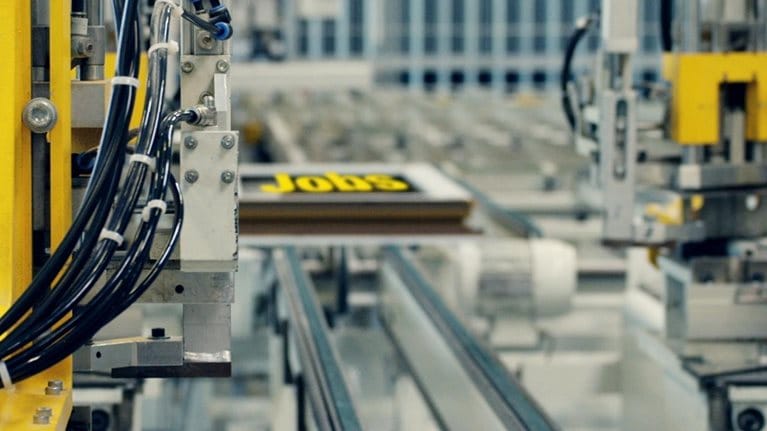The industrial sector will see more disruption within the next five years than it has in the past 20. Revenues will grow, but incumbents are ill equipped to capture their fair share. They will need to shake up their business models, their approaches to competitors, and the very core of their businesses to hold their own, let alone grow, in the face of a disruptive onslaught.
Stay current on your favorite topics
McKinsey sought to understand the implications of disruption in three industrial sectors: automotive, aerospace and defense, and diversified industrials (building and industrial technologies, machinery, and power equipment). We spoke to more than 300 senior executives from incumbents, start-ups, think tanks, governments, industry associations, distributors, and resellers around the world. The head of a semiconductor company summed up the situation facing the semiconductor sector: “We’ve had technology disruptions before, but the market was stable. Now the market is being disrupted as well as the technology.” What can incumbents do?
Disruption does not have to be bad news: companies that can capitalize on it have incredible opportunities, and disruptive forces will raise revenues in all these industries. Most industrial sectors will, however, find it hard to adapt quickly enough, and not all of today’s leading players will retain their positions. As one business leader said: “We will see a complete reshuffling of the industry, and a shakeout will happen. The end game is not clear.”
Insights
Our survey produced three sets of insights that will be both provocative and helpful as companies consider how best to answer the disruption. The first relates to the disruptive forces themselves and to the ability of companies to prepare for them, the second to the implications for incumbents of the new disruptive world, and the third to the way companies can deliver a sustained, successful response. Ultimately, the findings suggest that piecemeal solutions will fall short of what’s required. Riding the disruptive wave is going to take courage, vision, and grit.
1. Incumbents are grappling with five disruptive forces
Executives identified five forces that incumbents must address simultaneously to have any hope of capturing the increase in industry revenues:
- connectivity-driven business models, such as pay per use and data monetization
- artificial intelligence (AI) and autonomous systems, which go far beyond driverless vehicles and encompass machine learning and robotics
- the Internet of Things (IoT), which could have an annual economic impact as high as $11.1 trillion by 2025, according to the McKinsey Global Institute (MGI)
- electrification, driven by regulatory and technological changes and by growing consumer demand
- cybersecurity, which is growing in importance as connectivity increases between and within companies, production facilities, defense systems, and so on
Would you like to learn more about our Automotive & Assembly Practice?
We asked respondents to rate the impact of each disruptive force on their businesses, from 1 (no effect) to 5 (affecting at least half of the business), and to rate their readiness, from 1 (no measures in place) to 5 (holistic transformation started). Worryingly, the gap between readiness and impact is substantial in a number of areas, including cybersecurity, connectivity-enabled business models, AI and autonomous systems, and the IoT (Exhibit 1).

Although incumbents and start-ups agreed on the impact of each disruption, the latter see themselves as much better prepared. This confidence should be a wake-up call for incumbents, although the start-ups still haven’t proved that they can scale up. As the CEO of an automotive start-up put it: “Classic players are weak and completely unprepared. My experience is that start-ups do not have to fear incumbents, because they are able to act much faster.”
2. Disruption is upending the core of industrial companies
To capture the growing revenue pool, incumbents must understand what the speed of change, the evolving competitive landscape, and the impact on the workforce mean for them. But the new world is very different from the one they know. The drone market, for example, is expected to leap from $6.4 billion today to $23 billion by 2024. However, the additional revenue will come largely from software and services rather than manufactured products, so incumbents are losing revenues to attackers.

The pace of change is startling (Exhibit 2). Three-quarters of the executives cited speed as a major challenge. Companies that are keeping up with it realize that speed is not just about making faster decisions; the scale of change and the potential impact mean that those decisions must be more radical.
The competitive landscape is also changing fast. Incumbents are under attack from start-ups, on one side, and tech giants, on the other. (At a recent automotive trade show, several journalists reported that the bosses of major German car manufacturers were more anxious to attract Facebook CEO Mark Zuckerberg to the event than they were about Tesla or competition from China.) But a third of executives still see other incumbents as a threat.
Finally, disruption will have an enormous impact on the workforce. Even with technologies already in use, MGI research shows that 45 percent of the activities people are paid to perform today could be automated and that so could about a third of the constituent activities of 60 percent of all occupations.
3. What can incumbents do to stay relevant—or win?
Faced with these challenges, incumbents need to reassess how they work or even what they are. Business models need to change; competitors may become partners; resources must be moved boldly, not timidly; talent acquisition must change; and “agile” must be transformed from a barely understood notion into the way critical parts of the business are run.
Different business models will be essential (Exhibit 3). Companies need to shift from a focus on clever technology and instead think about business models from the outset. Pay per use is one of the most prominent ones we see emerging.

Even air is being sold on a pay-per-use basis. Compressor provider Kaeser offers usage-based contracts: customers pay only for the compressed air they use. Kaeser installs and operates the system, guarantees performance, and splits the efficiency savings with the customer.
Smart thinking like this extends to recalibrating notions of competitors, customers, and partners. Manufacturers, suppliers, and service providers must form alliances or join ecosystems—even with companies they might have traditionally seen as rivals or never thought about at all—for investment, for skills, or to build platforms that integrate entire industries.
Airbus, for example, is partnering with Uber to make it possible for people to book helicopters for a taxi service (an idea tested at the Sundance Film Festival); with hardware start-up investor HAX to develop, test, and commercialize vertical people-transport solutions for cities; and even with transportation-software company SITA to develop advanced cybersecurity solutions for the air-transport industry.
With so many avenues to explore, companies need to understand how to allocate resources appropriately. Basing budgets on last year’s spending is futile. So is moving a small share of money to a glamorous new digital idea. A third of our survey respondents believe that technology disruptions will make it necessary to reallocate more than 30 percent of the resources of their companies.

Competing in a world of sectors without borders
The evidence backs up their opinion. Companies that actively reallocate resources perform significantly better than their peers. Companies that move more than half of their capital expenditures over a 20-year period generate almost two times more growth in total returns to shareholders than companies that move less than 30 percent.
Some incumbents are adopting a zero-based approach to challenge their entire base spending—which can help shift mind-sets and money to where they are most needed. A European machinery player that shifted from a new-installation business to a service-based one built a hypothetical “model company” simulating how its business might develop in different markets. This helped it determine where it had too much capacity, which products to abandon, and how to secure its profitability.
As we mentioned, automation will displace employees, but the disruptive forces also require fresh skills. Data scientists, AI experts, and programmers are all in high demand. In the United States, 100,000 software engineers will be needed until 2030 just to cope with the increased complexity of in-vehicle software. As one automotive supplier told us, “We have to change from a mechanical-gear-cutting company to a technical and analytical company. The challenge is scarcity of talent!”

Half of the companies we spoke with expect to acquire such skills through M&A or partnerships (Exhibit 4). Other companies are turning to crowdsourcing for the skills they need. GE, for example, reduced the weight of a jet-engine bracket by 80 percent through an online design competition. The winning design was awarded $7,000, so the company, in effect, received thousands of person-hours of work at a fraction of the normal cost.
In response to the disruptive forces, respondents agreed most of all on the need for agility. Yet there is a huge mismatch between understanding the need for speed and taking measures to achieve it. Only a quarter of the respondents’ companies had initiated pilots or undertaken any sort of program to become more agile. An agile organization can implement new business models effectively—EBITDA margins, time to market, and frontline productivity all improve. The challenge is that there is no one formula for becoming agile; the starting point and context for each organization are different. Nor must every part of the organization be agile, though the whole operating model must change where agility would be of great benefit. However, almost three-quarters of companies implement only a couple of quick fixes, despite evidence that success is three times likelier when companies adopt much more comprehensive agile programs.
A menu of topics for incumbents to address is helpful but not sufficient. Industrial companies that want to build and grow through disruption will need to undergo a complete change.

The majority of survey respondents have already begun company-wide programs (Exhibit 5). Some transformations are well under way. For example, a leading European industrial company decided to build an IoT–digital business, and that required a thorough transformation. In less than a year, the company successfully tied connected services into its core product offering. At each stage of the process, it focused on its customers’ needs and initial reactions to guide the transformation.
Transformations are daunting and can hit many obstacles. Companies are asking employees to be faster, more entrepreneurial, and less risk averse. Meanwhile, the way people work is changing all around them with the rise of digital technologies, automation, and cybersecurity concerns.
Three challenges stand out. First, companies will have to become more courageous. Daring to be ambitious and to make (and learn from) mistakes will help companies redefine themselves. Second, companies must ensure that the transformation is inclusive. It is essential to have a strong commitment from the top, cascaded down through the organization and empowering all levels of employees to make improvements. Finally, companies must ensure that the transformation goes far beyond technology. In our extensive experience—backed up by our survey results—the biggest stumbling block for any transformation is usually corporate culture. As an automotive-OEM executive said: “The issue is not the organizational model; the issue is people and mind-sets.”
Our survey revealed widespread agreement among industry participants that they will soon be facing unprecedented disruptions. The five major disruptive forces are interlinked and will affect all industries. Most players, especially incumbents, do not yet feel fully prepared for these disruptions and therefore expect profound shifts in the competitive landscape.
Organizations will be forced to react on multiple fronts. Some players will undoubtedly struggle against these challenges, which may seem overwhelming, though they also present great opportunities. The timing has never been better for companies eager to set new ambitions.


